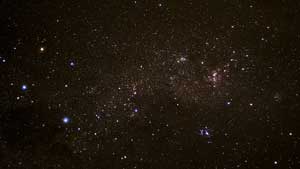
Source: Southern Cross, varrqnuht, Flickr
You are now going to quickly collect data about the two texts you read. This data will help you find connections between them.

The questions you will be asked are basic and could be used with many different kinds of texts. Use the your notes to write your answers. When you’re finished, check your understanding to see a possible response.
- Who is the narrator, or speaker, in each text? Is there a difference in how aware a reader is of the narrator for each text?
- In each text, who is it that wants something? What do they want? In other words, what is the speaker’s message in the poem, and what is the purpose of the article?
- What resolution occurs for the people who want something in each text?
- What is one obstacle in each text that has to be overcome?
In the poem, the speaker seems to be identified with the author. A reader is very aware of the presence of the speaker: there are five uses of the first-person pronoun “I” in the poem’s eight lines. Additionally, the content of the poem is largely about the responses of the speaker to the events described in the poem. There is no attempt to objectively record the events he experiences.
An article does not have a “narrator” as such, but the author is the speaker. In the article the speaker is almost invisible. We know his name (Jeremy Smerd) only from the byline. He doesn’t use first person pronouns such as “I” or “me” in the article. The events, plans, and responses of the people interviewed are all described objectively and from different perspectives.
These differences are primarily because of genre expectations. When you read a news article, you expect it to be objective; when you read a poem, you are expecting something much more subjective and personal.
In the poem, there is no explicit statement about what the speaker wants, but the words imply that the speaker wants to get out of the lecture hall and be alone as he walks and looks at the stars “from time to time.”
In the article, each of the people proposing projects wants the projects to go forward. Jason Kendall wants Dyckman Fields— some playing fields in the northwestern section of Manhattan—to be darkened on April 3rd and 4th. Katja Aglert wants lights in buildings around Times Square to be darkened for one minute. Both of these people want New Yorkers to become aware of the beauty of the night sky.
In the poem, the speaker wants to be alone and outside to enjoy the stars, and in the article, the two people want something to happen to other people in the city of New York.
In the poem, the speaker leaves and walks around outside. He gets what he wanted.
In the article, we don’t have any information about whether the two proposals are accepted and enacted, but we know that at least one person, Wsam Ottman, gets to see the night sky in a way that he’s never seen it before. In a small way, this helps to satisfy what Jason Kendall wants.
In the poem, the speaker has to get away from explanations about nature. The astronomer’s lecture stands between the speaker and the experience of walking and looking up at the stars.
In the article, the lights of the city stand between the people and the experience of the night sky.
In the poem, the speaker is acutely aware of what he is missing by being stuck in the lecture hall; in the article, many people are not even aware that the night sky can look very different from what they see every night. Jason Kendall and Katja Aglert are trying to give people an experience they haven’t had and also make them aware of what they are missing.
You could continue collecting more data, of course. You could, for instance, think of the tone in each text. You could comment on the settings. You could pick out important sentences and phrases or important objects. The depth of your data collection depends on your purpose and the time you have available.